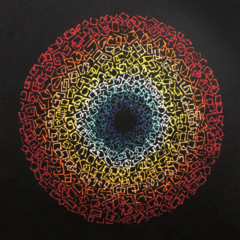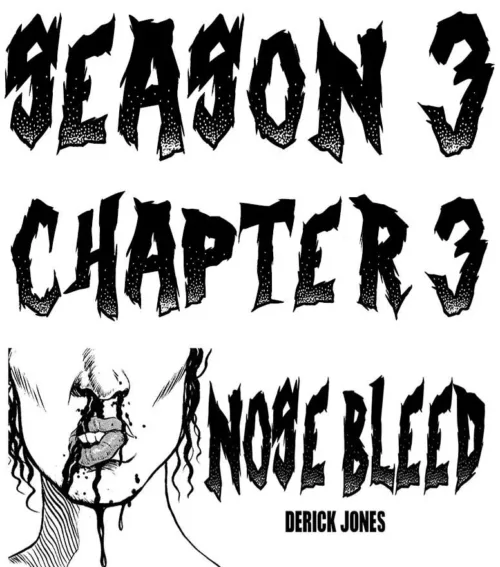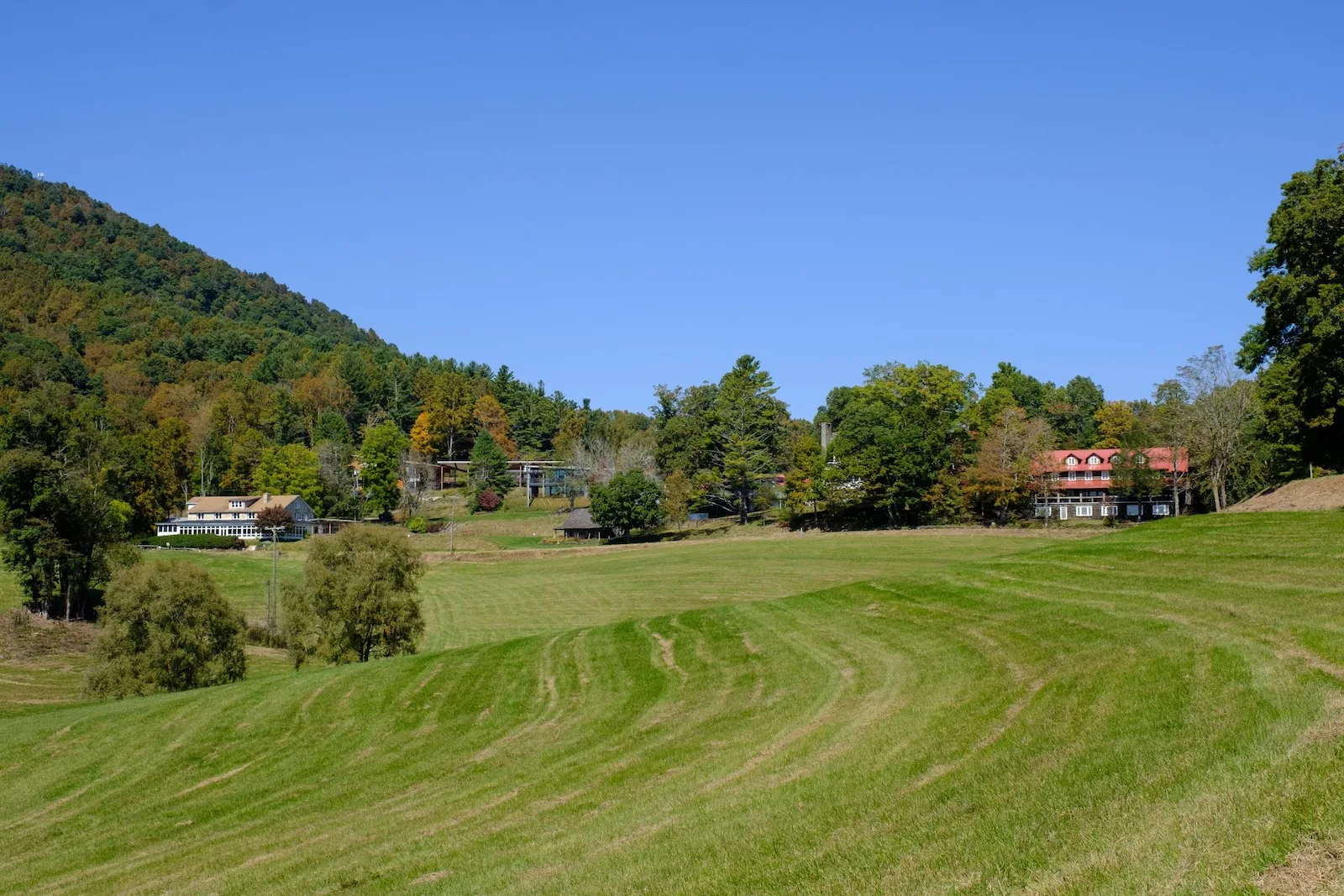
Author’s Introduction
This summer I took a two-week workshop in printmaking at Penland School of Craft in North Carolina with the artist Karen Kunc. The craft school is a well-known educational institution with a long history that began in 1929 with its founder, Miss Lucy Morgan, who first established it as an outgrowth of a craft-based economic development project she had started several years earlier to train women in Appalachia to weave so that they could make an income to help their families. Morgan retired in 1962, succeeded by Bill Brown who updated and expanded the school’s offerings, added longer fall and spring sessions, and created resident artist programs at the school. Penland is on the side of a mountain with 420 acres and 57 buildings. It is very beautiful. About 1,400 people now attend their programs each year. They have 12 studios: Books, Clay, Drawing & Painting, Glass, Iron, Letterpress, Metals, Paper, Photography, Printmaking, Textiles, and Wood.
Although I had taught about the history of Penland, along with other craft communities and educational opportunities in craft for my “History of American Craft” course at Towson University, I had never visited nor attended Penland. Once there for 24 hours, I realized it was a truly special place and determined to capture some of my experience in an article for Artblog. This article is the result of discussions while at Penland, Zoom interview follow-ups once back home, and email correspondence.
Craft communities tend to be in more rural areas of the United States as there is an understanding of the connection between making by hand and living in nature, where individuals can spend a concentrated amount of time creating without the distractions of daily life. Penland’s mission statement is “Make lives meaningful through making.”
Alida Fish
When I returned from Penland, I spoke with Alida Fish about my experience and asked for her thoughts. Alida is a well-known photographer who taught at the University of the Arts for many years. Since 1971, she served in various roles at Penland, from student to teacher and long-time member of the board of directors.
I asked Alida what made Penland unique. And she explained that one of the ways Penland is unique is its specificity of courses taught by invited artists who determine themselves what they want to teach. So, there are often unusual offerings. The artists come from across the United States. Some have taught at universities and art schools and others have concentrated on their studio practices.
Alida commented: “I like the fact that Penland successfully promotes generosity, flexibility, and respect. The first thing that comes to mind is the generosity of spirit revealed in the studios and throughout the campus. More often than not, a student group consists of a wide range of ages, life experiences, and arts training. The studios are open 24 hours a day and students become totally immersed in their studio activities; it is a non-competitive environment—they learn as much from each other as they do from their instructor. Although instructors design a specific workshop based on their professional activities and strengths—a workshop that takes place on weekdays over three hours in the morning and three hours in the afternoon—they quickly find out that their students really want to learn everything they know about their craft. It is not unusual during “off hours” on weekends and evenings to find instructors working on their own projects and chatting with and helping students at the same time. There is no way these thirsty students can absorb all the information they are receiving but they leave with an abundance of resources and ideas they can draw on later.”
She further stated: “While I’ve taught at a number of craft schools, I’ve never encountered the same degree of energy and positivity that I’ve found at Penland. There is an openness and flexibility there that fosters expansive thinking and experimentation.”
I found this to be true as well, and Karen Kunc made similar observations when we spoke.

Karen Kunc
Karen Kunc is an established artist with an international reputation. I have followed her work for some time, and when I saw that she was teaching at Penland, I decided to enroll. She was a professor of printmaking at the University of Nebraska-Lincoln for 37 years, and began Constellation Studios in 2013, which includes a gallery, workspace, and professional classroom in a refurbished and historic building in Lincoln, Nebraska’s Antelope Valley neighborhood. Constellation has printing presses, a type shop, wet paper studio, bookbindery, print and book collections, and mixed-use spaces. Kunc sees her role as mentor, artist, curator, and community organizer with a goal of developing young artists and spurring careers. She has given workshops around the country, including teaching at Penland three times, beginning in 1989, then in 2014, and now this summer.
Each time, she has concentrated on her color woodblock process developed over her extensive practice and for which she is well known.
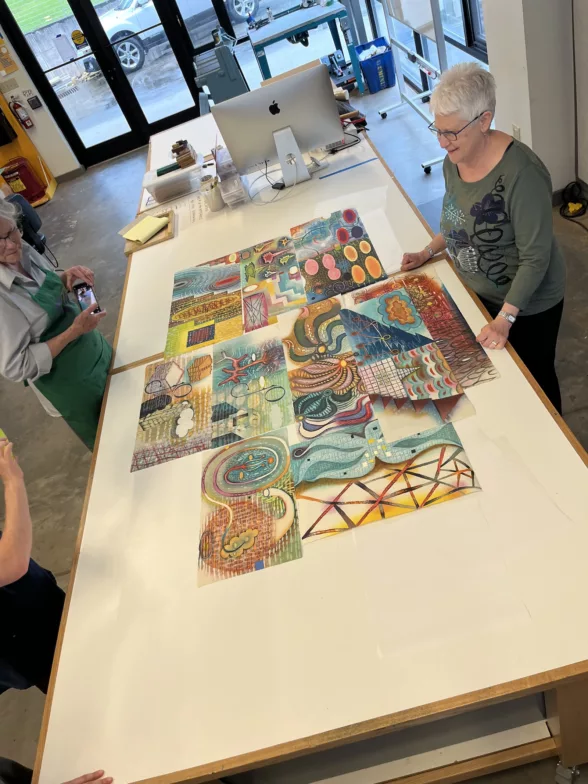
She explained, “Coming to Penland means teaching at one of the premier summer programs in the country. I had always heard of it, and even before I taught the very first time, I knew that Penland was a place to aspire to.”
It is not only the teaching experience but also the opportunity to meet other instructors through the evening lectures and to visit their studios as well. Karen commented, “I enjoyed the opportunity to meet instructors in the different workshop areas. Penland fosters those relationships through meetings, social events, and the instructor lectures.”
Her years of teaching were evident at Penland through her excellent organization, creativity, and detailed presentations as well as her individual comments to each participant.
When asked about her most recent Penland workshop, she said, “My experience this summer compared very well with the other earlier experiences. It was a great workshop with a high quality of students in the group. Camaraderie builds up with everybody working and sharing which I find empowering for creative risk taking for everyone, including for me too. So, it’s a marvelous experience, and of course we were all exhausted at the end, but elated by the accomplishments and the beautiful works that were made. I’m very proud of what the group did.”
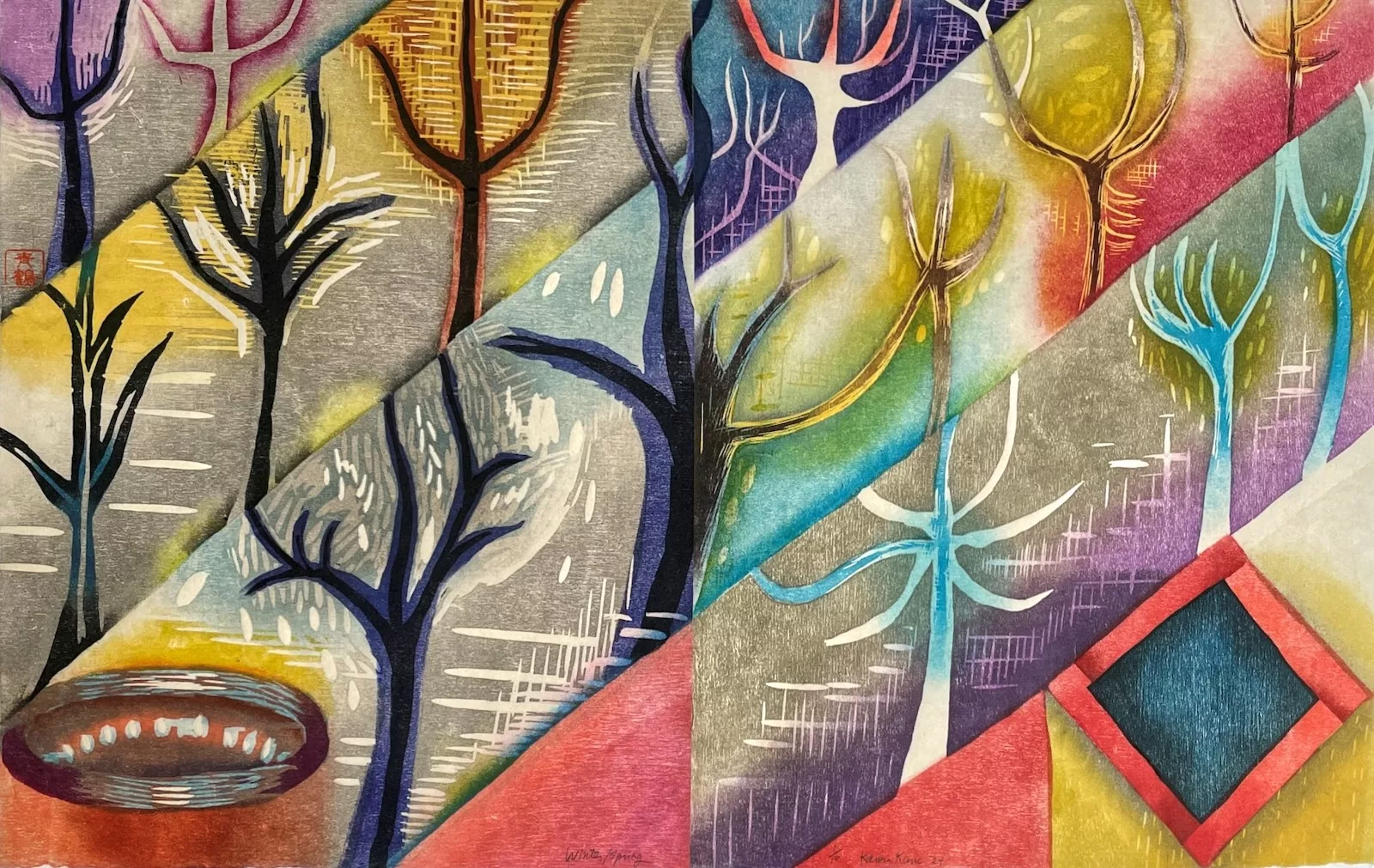
This is the work she created while at Penland; she donated one of each of these prints to the Penland art auction.
Karen set an ambitious agenda with three projects, each more complicated than the last. While she recognized the degree of difficulty, she finds that “everyone goes through a struggle that creates a pathway of creativity that is this excitement and crash, excitement and crash, which really leads to developing something in the print that starts ‘speaking’ to the maker about what is needed for a resolution…a color accent, detail, or contrast etc…”
The class of 12 included non-professional artists, professional artists, arts educators, and art students. Like Alida, Karen sees the interaction between the more experienced and the novices along with the professional artists and others contributes to the success of the workshop.
Artists at varied levels, from students to professionals
Two examples of the range of students who were in the workshop are Ethan Bisselberg, an undergraduate at Tyler School of Art and Architecture, Temple University in Philadelphia and Lisa Beth Robinson, Associate Professor of Art in the School of Art and Design, East Carolina University in Greenville, NC. Ethan is going into his senior year, majoring in printmaking and minoring in art history. He said that people at Tyler had been talking about Penland for his entire time there, so it was something that he was thinking about. And then this summer he had enough free time to dedicate to taking a workshop. He began to look at classes at Penland and Haystack, and other craft schools in the area, like Peters Valley. Then he saw a class in woodblock printing at Penland, commenting, “Printing is one of my favorites and there’s not really facilities for reduction printing at Tyler, and I have been wanting to invest more time and knowledge into it.” (Reduction printing is a process to make a multi-layered print from one block that is carved, printed, carved again, printed again, until the finished result is achieved). Ethan received a scholarship from Temple University to attend this workshop.
Lisa Beth is the proprietor of Somnambulist Tango Press where she makes artists books (letterpress, papermaking, printmaking), broadsides, fine art, installations, and curates exhibitions. She has been going to Penland since 1999 in various roles from student to teacher. This was her 8th time. She says there was only one time when she learned something that she did not put into practice, but even then, she found that she was still learning tricks and tips that are useful. She likes the small class size and the one-on-one approach to teaching. And, like Alida and Karin, she finds Penland great for meeting people. And she also comments that over the years, the facilities have gotten nicer and nicer.
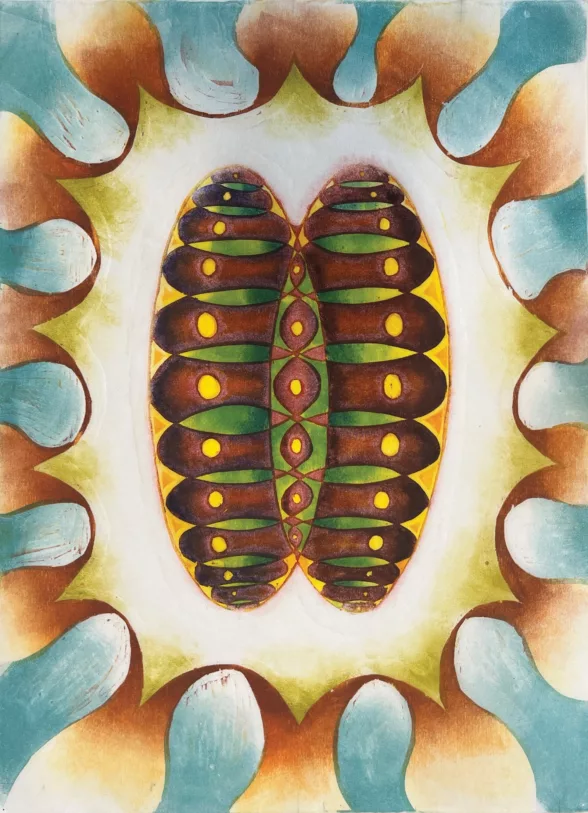
Each workshop has a studio assistant. Kunc recommended Angelica Tapia Estrada, who is in the MFA program at the University of Nebraska-Lincoln. Ever the teacher and mentor, Kunc said that “it was a valuable opportunity that I could extend to an emerging artist and student.”
Angelica is in her third year at UNL with an emphasis on painting and drawing and a minor in printmaking. She had taken a three-day workshop with Karen at Constellation Studios on the Japanese Mokuhanga printing technique (a special relief printing with water-based inks). Ours was a nearly two-week class. Like many students I met at Penland, her school too provided a grant to support materials and travel while Penland supplied room and board. However, there are scholarships available to students and educators, and many participants contributed works to an art auction supporting scholarships, that was organized and took place the last night of the session.
Angelica was an excellent assistant, keeping us supplied with materials and answering many questions. Penland provided our paper, inks, and carving and printing tools. It was a superb studio and Angelica worked with their full-time staff to make sure it was ready to go each day. Students worked nights and weekends too, so a lot of materials were used. Also, Angelica was able to create prints alongside the students in the class. She found – in speaking with other assistants – that this wasn’t necessarily the case in all studios. The assistants each also presented a brief lecture about their work to the Penland community. Angelica told me that she found Penland to be a great experience.
Another assistant who I spoke with is Paulette S. Hartman, who recently received her bachelor’s degree in Jewelry/Metalsmithing/CAD-CAM at Tyler School of Art. She found out about Penland through a friend who attended a glass blowing program there. Paulette told me that it became this thing that she always wanted to do, and when she discovered there was going to be a titanium anodizing workshop (a type of electrolyte finishing process for metals) with one of her former professors, Mallory Weston, she decided to apply. She was chosen to be the studio assistant and describes it as a wonderful experience.
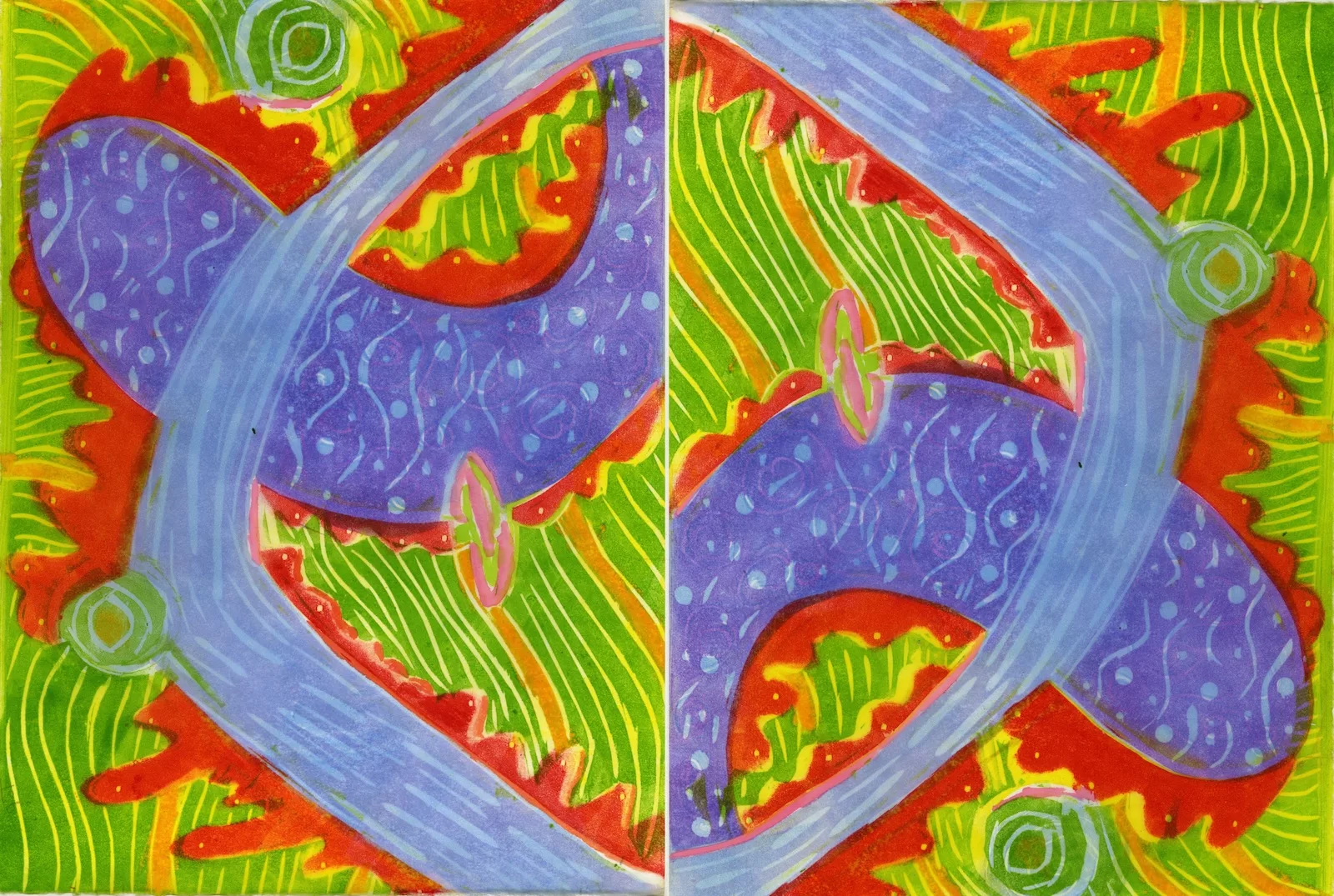
Penland was terrific for me, too. I had just retired in January from teaching art history and curating the Department of Art + Design Galleries, Towson University and officially entered the Towson MFA in Studio Art program as a graduate student. I had shown Karen Kunc’s work in some of my classes. I am not someone who is relaxed in nature. I am allergic to everything and find avoiding mosquitoes, ticks, spiders, and poison ivy very stressful. However, I spent every day in the studio, and attended lectures in the evenings. I soon forgot much of my fear of nature. I am not saying that I went on any hikes, but I loved the fact that I was surrounded by beauty and was completely taken care of. Supplies were provided as were meals. Penland for me cemented the fact that I was finally away from grant writing, prepping, teaching, and grading, and could just make art.
Further reading about Penland School of Craft
Inspired: Life in Penland’s Resident Artist and Core Fellowship Programs, Jean W. McLaughlin, Ed. Penland, North Carolina: Penland School of Crafts, 2016.
The Nature of Craft and the Penland Experience. Jean W. McLaughlin, Ed. New York: Lark Books 2004.
Gift From the Hills. Lucy Morgan and Legette Blythe. First edition published 1958. Penland School of Craft edition, 2005.


